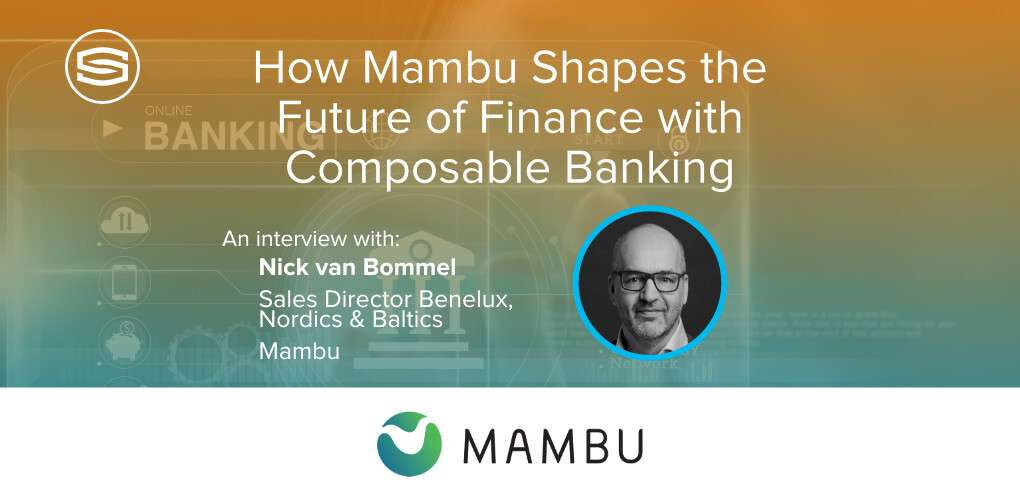
Insights & Opinions
How Mambu Shapes the Future of Finance with Composable Banking
Wed, 16 Nov 2022


One of our Corporate Members is Mambu. Banks (both big and neo), lenders, fintechs, telcos, and even retailers, are turning to Mambu to help them build modern digital financial products faster, securely and cost-effectively.
We spoke to their Sales Director Benelux, Nordics & Baltics, Nick van Bommel, on what composable banking means, how they contribute to a better banking industry and the impact of embedded finance on the future of that industry.
Hello Nick, you are the Market Sales Director of Mambu. Can you tell us how your organisation contributes to the future of banking?
Nick: I'm excited to work for Mambu, a company that started 12 years ago with the ambition to be a true differentiator in the core banking space. We want to bring delightful core banking experiences to customers.
The three founders saw the opportunity to build a cloud-native, pure SaaS API-first solution that is fully configurable. We believe in ecosystems, and so, to allow easy integrations with APIs, we run on the three largest cloud providers, meaning we are flexible in implementation, whatever your location and cloud appetite.
One of the key elements of Mambu is that banks configure and do not customise. So by doing so, we make the experience of implementing core banking for existing or new players easy and different. And that's what Mambu is about.
Really interesting. Whom do you consider your main clients? Is it FinTech companies or, rather banks and neo-banks?
We get this question a lot. Companies like Mambu have a journey where the offering grows with the type of clients you have. You don't start with the biggest, most complex clients.
Today we have different types of customers, from large to small banks to fintech companies. They all have in common that they want a quick time to market for distribution, and they are fully bought into the story of using APIs to integrate with other components of the architecture.
They all want a differentiated customer journey from a digital bank perspective, so they're typically tech-savvy organisations that choose best-of-breed solutions. Today, 250 clients, including the bigger tier-one banks, use us for part of their offerings.
We focus on starting small and expanding later. And what you also see is that our clients typically start in one country, experience the benefits of the cloud offering, and understand how easy it is to scale this to a second or third market.
Many years ago, Mambu got my attention with the term composable banking. What do you mean by this exactly?
Seeing this term being copied is probably a compliment in one way. Mambu was indeed the first party to use it. Today we hear it more often.
The financial sector is changing tremendously, both from customer demands, the regulator, and the competitiveness perspective with the fintechs or other banks. You need an architecture that allows swift changes in a short time. The composable banking topic explains how you can select best-of-breed solutions around your core and build the bank you want to be, like Lego blocks.
Typically, SaaS offerings will all come with native APIs so you can integrate new solutions off the shelf to build your bank as you wish. But sooner rather than later, you might want to change your AML, some of your front-end solutions, or your offering for example. With composable banking, it's effortless to make those changes.
We believe that composable banking is at the heart of Mambu's offering.
This resonates pretty well with the next question. Banking is about realising dreams, as dreams change over time, and so should banking. Agility and fast time to market of recomposed elements should be at the heart of managing businesses that realise dreams, isn't it?
Realising dreams is the highest goal, right? You could say that as a vendor, we contributed to that by bringing agile solutions and faster time to market.
Just look at today and compare it with 10-15 years ago when banks implemented everything in the old way and ran on their own data centres or on-premise. Nowadays, fintech companies jump on new opportunities to realise clients' dreams, and the incumbent banks need to adjust to new competition. In parallel, they are setting up their own new initiatives to remain competitive.
I think the critical thing about realising dreams is that clients have become so used to amazing customer experiences, typically starting outside the banking world. So, customer experiences are changing; customers expect to deal with their bank in the same convenient way as they do with other vendors or strategic partners during their life.
Banks are catching up. The dreams are happening today, and a composable banking architecture is delivering upon its promise to deliver very cool and new digital experiences.
Another essential aspect of realising dreams is that the bank's business these days is increasingly more embedded in non-financial customer journeys. What is your and Mambu's experience with this?
Talking about buzzwords 😉. The nice thing about embedded finance is that typically if you don't see it, it is delivering upon its promises. It means it is embedded in the customer experience, which is not with your bank but with another vendor.
In our offering, we have had a stored-value digital wallet solution for quite some time for some of our PSP clients, merchants or e-commerce players. In that respect, embedded finance is not entirely new to us.
Another hot topic in embedded finance is BNPL (buy now, pay later). With Mambu, we can provide the engine behind some of the lending required to provide BNPL. We sell that engine directly to banks who want to offer a BNPL solution and also to merchants.
Banking-as-a-Service (BaaS) is another offering linked to embedded finance. We can help BaaS providers with a flexible engine so they can easily serve multiple clients across different regions cost-effectively. We have more conversations and partnerships with players that wish to reinforce their strengths by building on our strengths. Our software and their license altogether become an end-to-end BaaS offering.
Mambu is not a licensed party, and we have no plans to be so.
One last question is about cloud technology, which is clearly at the heart of your business. What do you think about some IT executives that remain loyal to the mainframe for some of their core banking, business lines, like payments?
I'm long in the business, but even for me, mainframes have always been something which we would call old technology. Still, many banks remain dependent for some of their critical components on a mainframe. This is not done overnight. This takes long journeys and typically not the easiest of projects.
Mambu was born in the cloud. We typically see that in a bank with a mainframe, the business and product marketing will pressure IT executives to consider alternative, more agile solutions to replace the mainframe.
Parties like Mambu can help with what we call speedboats, where next to the core offering that the bank has, which is difficult to change, new initiatives pop up, typically on the side. They may reuse the same channels, but at the core, new solutions like Mambu are typically used to orchestrate this. And the speedboats are serving the cause because innovation and product development can continue.
This builds up the confidence that the new technologies are fit for purpose, and it allows the client to move some of the functionalities from the old stack onto the new stack, and then it becomes part of a strategy for the transformation.
So we typically see that with the bigger banks to be their first projects. But it will take time. And I don't think that any new player will ever start on the mainframe as this is something that the large tier one banks have as a heritage almost. The fact that we all go to the cloud is probably a given for all the good reasons.